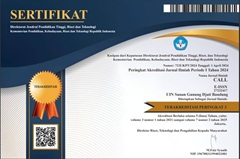APPLICATION OF AN ADAPTATION APPROACH THROUGH NARRATIVE COMPARISONS IN THE NOVEL AND FILM TWILIGHT
DOI:
https://doi.org/10.15575/call.v6i1.24074Abstract
In the realm of fine arts, it is common for one form of art to draw inspiration from another, a process known as transformation. This research focuses on the film adaptation of literary works, examining the ecranization of novels into films and the use of adaptation theory to convert novel texts into visual films while preserving the essence of the novel as a hypogram. The study employs a qualitative descriptive method, utilizing close reading and close viewing techniques. It classifies the transformations using Pamusuk Eneste's ecranization (1991) approach and Seymour Chatman's interpretation theory (2018) of the change process in novels and films. The findings reveal that films often include additional stories to convey the setting more explicitly. Although various settings are altered, these changes are justified as it is often impractical to visually depict the atmosphere detailed in the novel. The introduction of new characters in the film aligns with the expanded plot, necessitating the inclusion of characters absent in the novel. Additionally, the visualization of characters in the film undergoes modifications, yet remains consistent with the novel's descriptions. Backgrounds are condensed to fit the film's plot, resulting in the omission of some novel locations in the film adaptation.
Keyword: transformation, ecranization, novel, film, twilight
References
Aspriyanto, Y., & Hastuti, E. (2019). Transformation of a novel murder on the orient express into its film adaptation using ecranization study. Jurnal Pendidikan Bahasa dan Sastra, 19(2), 211-219.
Chatman, S. (2018). Story and discourse: Narrative structure in fiction and film. Cornell: Cornell University press.
Creswell, J. W. (2018). Research design: Qualitative, quantitative, and mixed method approaches. Los Angeles: SAGE Publications, Inc.
Eneste, P. (1991). Novel dan Film. Flores: Nusa Indah.
Jha, S. (2020). Aristotle's mimesis or creative imitation. The Creative Launcher, 5(1), 32-36.
Hidayat, M., & Weda, S. (2021). A comparative study of narrative structure in the novel and film “the jungle book". ELITERATE: Journal of English Linguistics and Literature Studies, 1(1), 52-62.
Jabrohim. (2015). Teori penelitian sastra. Jakarta: Pustaka Pelajar.
Karma, R., & Saadillah, A. (2021). Ekranisasi dan relevansinya dalam pembelajaran bahasa Indonesia di sekolah. Jurnal Onoma: Pendidikan, Bahasa dan Sastra, 7(2), 696-704.
Kamiliya, S. A., & Saraswati, L. A. (2023). Ecranisation of serendipity novel by Erisca Febriani into serendipity movie by director Indra Gunawan. Crossover: Journal of Adaptation Studies, 3(1), 33-49.
Muhandra, A. P., Siregar, A. N., Pratiwi, R., Siloto, H., & Sopha, D. (2023). Analysis of intrinsic elements in short stories by Widya Suwarna. PHILOLOGY: Journal of English Language and Literature, 3(2), 49-55.
Nasheeda, A., Abdullah, H. B., Krauss, S. E., & Ahmed, N. B. (2019). Transforming transcripts into stories: a multimethod approach to narrative analysis. International Journal of Qualitative Methods, 18(1), 1-20.
Nurgiyantoro, B. (2010). Teori pengkajian fiksi. Yogyakarta: Gadjah Mada University Press.
Ramdani, P., Saehu, A., & Pramita, A. (2023). The characterization adaptation in the novel and the film of “and then there were noneâ€. E-Journal of English Language & Literature, 12(3), 582-609.
Downloads
Published
Issue
Section
Citation Check
License
Authors who publish in CALL agree to the following terms:
- Authors retain copyright and grant the journal right of first publication with the work simultaneously licensed under Attribution-ShareAlike 4.0 International (CC BY-SA 4.0) License that allows others to share the work with an acknowledgment of the work's authorship and initial publication in this journal.
- Authors are able to enter into separate, additional contractual arrangements for the non-exclusive distribution of the journal's published version of the work (e.g., post it to an institutional repository or publish it in a book), with an acknowledgment of its initial publication in this journal.
- Authors are permitted and encouraged to post their work online (e.g., in institutional repositories or on their website) prior to and during the submission process, as it can lead to productive exchanges, as well as earlier and greater citation of published work (See The Effect of Open Access).




